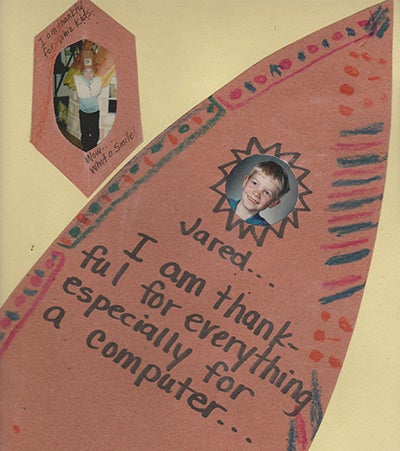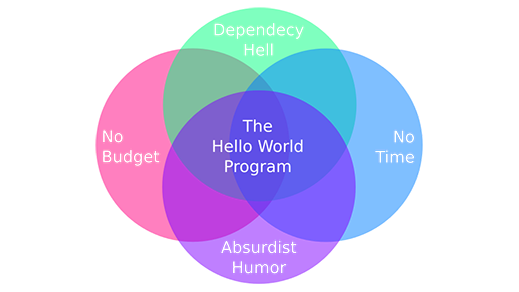Growing up with Windows, it seemed there was always something wrong with my family's computer. Our PCs didn't stay new for long. Yet, as annoying as it was to load each installment of the King's Quest series by copying data from five or so 5.25-inch floppy disks, I did appreciate being able to easily access the inner depths of our PC while learning BASIC and some C.

I have no doubt that many of the problems our computer suffered from were caused by me poking around and tweaking things I didn't fully understand. (Sorry Mom and Dad!) Home was a small town in rural Utah, and my secondary school education provided few opportunities. Art was the only class that opened a window to a world beyond corn fields and feedlots, so I picked up the pencil and drafted my own future. I left home for college to study painting, but once there I found myself immediately drawn to the tech labs and shifted my focus to learn digital audio processing and video editing.
The first computer I purchased for myself was a 13" Powerbook G4 in 2002. Prior to that, I managed to get by using the computers available to me in libraries or dedicated labs. I was a student in the Studio for Interrelated Media at Massachusetts College of Art and—as is still the case—the art and design world at the time preferred Apple computers. So that's what I bought, and I loved it. The thing was a beautiful workhorse, far superior to the junk I used as a kid. I pushed it to its limits, editing video and processing audio ruthlessly day and night. But after four years of hard use, it started to show its age.
Though I loved my G4, it was far from perfect. Each time I upgraded the operating system (OS), my computer slowed in a degree that was not commensurate with the enhancements. With each update I found myself relearning the interface and finding it more and more dumbed down. To add insult to injury, I was shelling out about $100 for each new version of OSX, which is a lot for a young artist. But this didn't shake my faith. I was in the club and no way was I going back to Windows. So when I got to grad school, I purchased a 15" MacBook Pro, the first generation with Intel chips. I was sorely disappointed. Not only did I find the changes to the software obfuscating for a power user, the hardware didn't perform as well as my G4 and suspiciously went into rapid decline just after my AppleCare package expired.
It was around that time that I had a studio visit with the avant-garde filmmaker Babette Mangolte. We discussed the turn of cinematic production from analog to digital and the tools now available to media producers. She told me she was learning C to write her own video compositing scripts to get effects that were singular and unique and not available in any NLE software. After my meeting with Babette, I began to focus on the medium (in the McLuhan sense) and became very good at discerning which software package a given artwork was created with and how the constraints of that software influenced the final product.
At the time, artists were primarily working with Final Cut Pro and After Effects, though some were venturing into Maya. It's much harder to discern today as the capabilities of individual software packages have increased alongside the proliferation of new editing and compositing software (not to mention widespread adoption of processing, OpenFrameworks, and MAX/MSP/PureData). What does it mean when the means of production are abstracted? In Mangolte's youth, filmmaking was a hands-on, material process that required splicing cellulose with a steel knife and tape at an editing station. For most artists today, it's a GUI with icons to be dragged and dropped in a timeline on a laptop.
On nearly every syllabus in the MFA Studio Arts program at the University of California, Irvine was Walter Benjamin, Guy Debord, or Frederic Jameson. Dissatisfied with the prescribed readings, I investigated other luminaries ranging from Georges Bataille, Lewis Hyde, Michael Hardt, and Antonio Negri. Somewhere in the midst of the madness that is an MFA program, I picked up a copy of Richard Sennett's The Craftsman. I am the first Nielsen to go to college. I hail from a long line of carpenters and stonemasons, so I was very interested in reading a work that investigated the philosophical and academic implications of craft. In a nutshell, Sennett defines craftsmanship as the desire to do a job well for its own sake. One of the many examples that he uses to illustrate this thesis is the Linux kernel and its contributors.
I'd heard about Linux, but I thought it was scrolling green terminal output on black monitors for Hollywood hackers and geeks. Reading Sennett write about Linux in such a way that connected free, open source software to craftsmanship (and radical, avant-garde politics) piqued my interest. Unhappy with the standard computing options and wanting a deeper understanding of the means of media production, I made a leap into the void and built a Linux desktop. It was my first rig and my first distro (Ubuntu). The learning curve was steep and the new environment put a serious hamper on my creative output as there was no 1:1 correlation between the tools with which I was familiar. I began working with openFrameworks and while a visualist-in-residence at The Institute of Cultural Inquiry, created my first truly open source art work.
After graduate school, I took a job as an exhibit technician at the Natural History Museum in Los Angeles. One of my many duties was to update and repair ailing exhibits. Many of our installations were powered by PureData, which is cross-platform, so when and where possible I would revive the lagging Windows PC with a minty fresh Linux distro. Many of our mechanical installations were built on PICChips. I swapped out the dusty microcontrollers with new Arduinos, writing and troubleshooting the new scripts in crawl spaces and back rooms with a Linux-powered laptop.
My biggest project at the museum was overseeing the installation of a scale model of downtown Los Angeles. It was a delicate operation, and to ease the minds of vested interests I created an animation in Blender explaining the procedure. It was a proud moment both for me and for FOSS.

It was around this time that I convinced my brother to not only move to Los Angeles, but to give Linux a try. As a web developer, Linux greatly improved his workflow. We began to collaborate on projects and developed The Hello World Program, an educational and entertaining webseries teaching computer science basics. It's not easy producing professional media with FOSS on Linux. This Venn diagram illustrates how we arrived at The Hello World Program.
We initially wanted to produce the series entirely with free, open source software. But after investigating all of the available NLEs and DAWs, we realized that our fidelity to FOSS would leave us devoting more time to troubleshooting than to production. That said, we produce all of our media entirely on Linux-based machines. All of the motion graphics are produced using a combination of Blender, Synfig, Krita, GIMP, and Inkscape. Our audio is processed with Audacity and Ardour. Our video is edited with Lightworks and our music composed in Bitwig.
Though FOSS may have its limits, it's so much more interesting to be engaged in the process. And where FOSS software works, it works so much better than its proprietary counterpart. Before I left Utah for greener pastures, I worked for many years as a wilderness survival instructor. Using FOSS tools is not dissimilar. Starting a fire with a bow-drill and compiling a software package from source are two open technologies on a long, fascinating continuum.






3 Comments